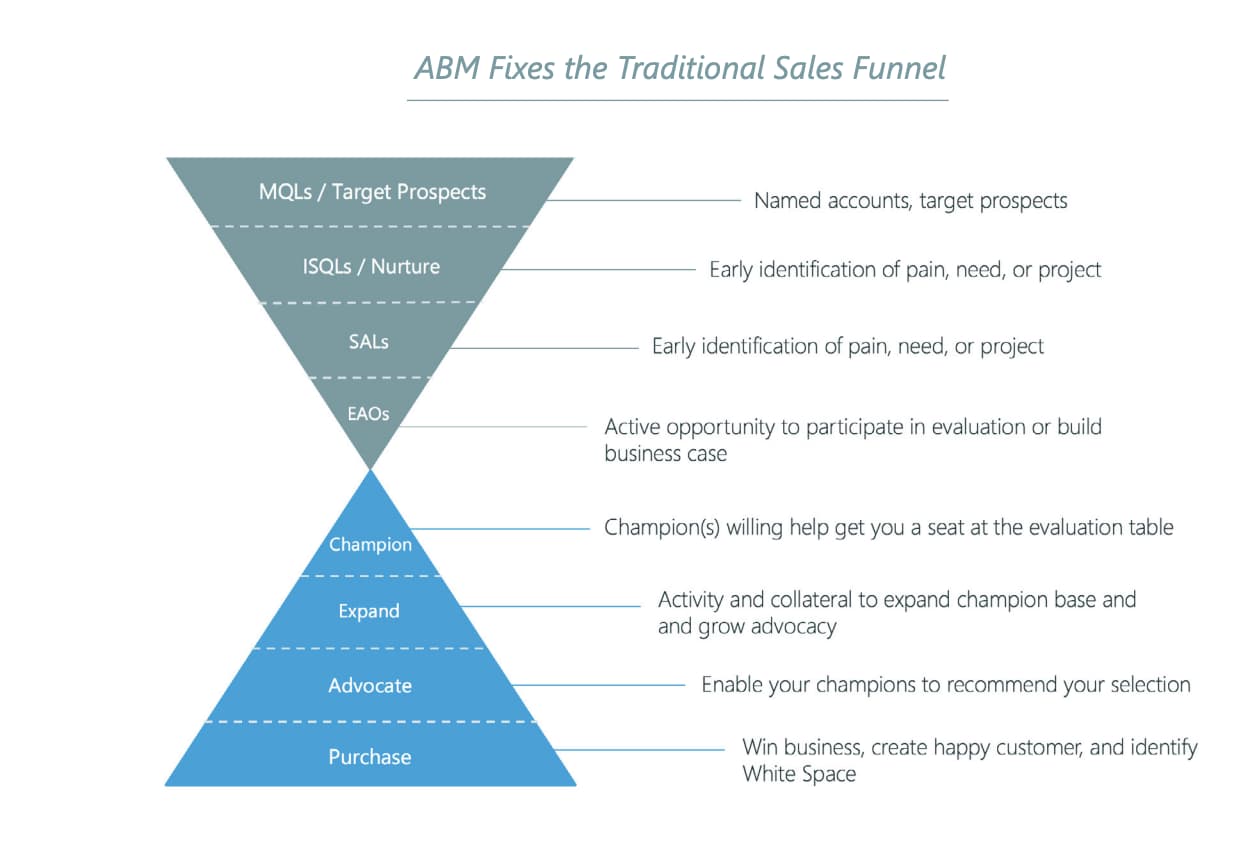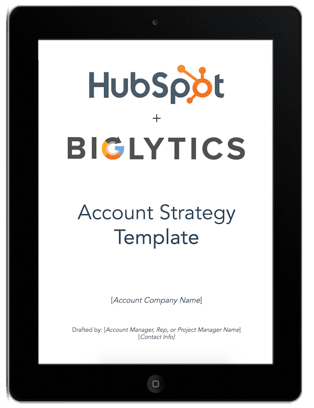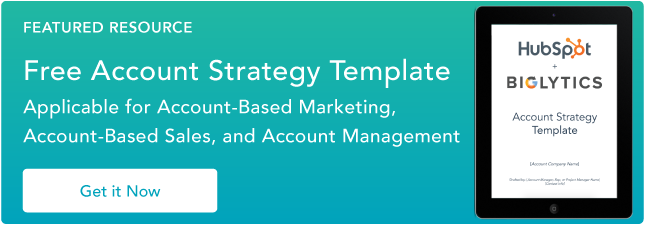The Ultimate Guide to Account-Based Marketing (ABM)
Imagine a world where you could start the sales process by selling directly to your best-fit, highest-value accounts. No wasted time trying to market to unqualified leads who aren’t the right fit for your business. Meaning, you could move...

Imagine a world where you could start the sales process by selling directly to your best-fit, highest-value accounts. No wasted time trying to market to unqualified leads who aren’t the right fit for your business. Meaning, you could move straight into the phases of engaging and delighting your target accounts. Talk about efficiency, right? Account-based marketing allows you to weed out less-valuable companies early on and ensure Marketing and Sales are in complete alignment — in return, your team can leap into the critical processes of engaging and delighting those accounts much faster. ABM helps your business work and communicate with high-value accounts as if they’re individual markets. By doing this — along with personalizing the buyer’s journey and tailoring all communications, content, and campaigns to those specific accounts — you'll see greater ROI and a boost in customer loyalty. Account-based marketing (ABM) is a focused growth strategy in which Marketing and Sales collaborate to create personalized buying experiences for a mutually-identified set of high-value accounts. Before we take a look at the additional benefits of account-based marketing and specific tactics you can implement at your company, let’s review its relationship with another important strategy: inbound marketing. Batman and Robin. LeBron and D-Wade. Peanut butter and jelly. Arguably some of the strongest partnerships ever to exist 💪. These dynamic duos are forces to be reckoned with. Similarly, when paired, account-based marketing and inbound marketing have the power to make waves (the good ones) for your business. You might be wondering, "How exactly does this partnership work?" Well, we just reviewed the definition of account-based marketing — as you learned, ABM is a highly-targeted strategy. Meanwhile, inbound marketing is more foundational — this methodology and growth strategy allows you to attract customers through the creation of valuable content, SEO, and a delightful customer experience. Rather than interrupting your target audience and customers (as you would with outbound marketing), inbound marketing allows you to more organically provide your audience with the information they want when they want it. Inbound lays the foundation for a strong ABM strategy by allowing for highly-targeted and efficient resource allocation of high-value accounts. Here are a few more reasons to implement both ABM and inbound marketing strategies at your company: 🧡TLDR: Combine ABM and inbound marketing to grow better. ABM works differently from a traditional sales funnel. Though ABM can be implemented across different industries and types of businesses, a general framework needs to be followed to ensure its effectiveness. Here are the key components of an account-based marketing framework. The working relationship between sales and marketing organizations is mentioned several times throughout this article, because its importance can’t be overstated. To have a comprehensive approach to ABM, and to ensure target accounts receive an engaging buying experience, marketing and sales have to be on the same page. When implementing ABM, sales and marketing organizations will need to agree upon resource allocation for each target account, assigning roles and responsibilities to ensure a seamless transition for the customer between marketing and sales activities, and determining how to measure the success of their efforts. How does your company determine what constitutes as a high-value account? Creating an ideal customer profile for the accounts your company wants to target is a key component to answering this question and creating an ABM framework. It’s also worth noting both marketing and sales should be participating in these conversations. As you determine what qualifies a potential account, consider these factors: Once marketing and sales are aligned on approach and which accounts to target, it’s time to map out a go-to-market plan. Understand exactly how a new customer would move through the sales process using an ABM approach. While preparing to go to market, you may find areas of friction that need to be addressed or areas of poor communication that can be strengthened. Additionally, because a personalized experience is so important in account-based marketing, your team will want to be on the lookout for additional ways to add value and deliver a premium experience to these accounts. In order to get the most out of an account-based marketing approach, you’ll need a sound strategy in place. Consider following these steps to create and implement an effective account-based marketing strategy. Marketing-sales alignment is crucial for successful account-based marketing implementation. In order to create a custom buying experience, a customer will need to have a seamless transition from being acquired as a lead through the final sale. To improve synergy between marketing and sales, both organizations must commit to clear communication and find a middle-ground to ensure the marketing team is acquiring leads the sales team can properly sell to. If you’re just getting started with ABM, having a small task force of one marketer and one salesperson who work together to identify and sell to target accounts is sufficient. As your efforts scale, prioritize having your marketer support additional salespeople, as one marketer can typically remain aligned with up to 10 salespeople, and each salesperson can manage up to 10 accounts. Once marketing and sales align on their approach, the organizations can work together to ensure your company is targeting the correct account personas. This usually begins with a period of research to identify which accounts to pursue. When identifying customer personas for an account-based marketing approach, marketers should consider: Though there are countless ways to identify key accounts, what’s most important is that marketing and sales agree on which accounts to target. According to HubSpot Academy professor Kyle Jepson, "If your marketer is targeting one list of companies, and your salespeople are working a different list, you’re going to end up with an account-based mess." After determining which accounts to target, it’s time to build account plans. This entails having the marketing and sales teams work together to map out the potential leads they’ll need to attract to reach their target accounts, and what content they’ll need to produce to engage with this audience. When creating an account plan for your ABM strategy, keep these best practices in mind: Ideally, using Inbound methodology will help you attract contacts associated with your target accounts. If you need additional contacts, your next step is to determine where your ideal contacts are currently going to find solutions related to what you offer and make sure your company is visible and represented in these spaces. Places you may get in front of contacts include events, industry publications such as blogs and newsletters, and targeted ad placements. While it can be tempting to try to get visibility for your company through all available avenues, prioritize the channels that are most relevant to your target accounts and contacts. As you build relationships with key contacts, make sure both sales and marketing are actively engaging everyone who will be involved in the buying decision. Though this point in the buying process is typically led by sales, marketing should be ready to support by creating relevant materials to reinforce messaging. To measure the health of an ABM strategy, marketing and sales teams can use the following metrics: Once this strategy is in place, your marketing and sales organizations can repeat the process with new and existing key accounts to attract and retain high-value customers. There are a number of benefits associated with account-based marketing. We've compiled the following list of commonly-noted results that positively impact all types of businesses. Cross-team collaboration and improved communication across any organization are beneficial to growth. In terms of account-based marketing, this transparency and alignment will ensure your marketing and sales teams are focused on the same goals, stick to the mutually agreed-upon budget, and understand the specific roles of each internal stakeholder. This alignment helps ensure all communications, interactions, and content are consistent for the accounts you work with. Meaning, no matter how long an account works with your company, your team members can pick up where others left off at any point in time without question — this creates a seamless and delightful customer experience. 🧡The easiest way to maintain internal account-based marketing alignment is with the help of software, like HubSpot, which makes connecting your marketing and sales teams exceptionally easy. Account-based marketing requires you to personalize everything (e.g. content, product information, communications, and campaigns) for each account you invest your resources in. Through this personalization and customization, your relevance among these accounts is maximized. That’s because your content and interactions are tailored in a way that shows them how your specific products, services, and other offerings are what they need to solve their challenges. Meaning, ABM allows you to angle your business in a way that makes it the most relevant and ideal option for your target accounts. For your ABM strategy to be remarkable, you must maintain a long-term sense of delight among your accounts. Each account should feel as though they’re your business’s market of one. Tackle this by offering consistent customer experiences. ABM is a strategy that requires major alignment between Sales and Marketing — so hone in on that when working to deliver those consistent experiences. Ensure all team members are aware of where an account is in the buyer's journey — then, deliver personalized and timely communication, campaigns, product information, and pricing details. With account-based marketing, you can easily measure return on investment (ROI) for each account you invest your resources and time in. This is beneficial because you can confirm whether certain accounts you invested in were ideal for your business. Then, you can nurture and delight those accounts long-term to retain them, as well as identify and target similar accounts in the future. If your ROI proves the ABM tactics you implemented worked, use that data to propel your strategy forward. Depending on your business, industry, and resources, the sales cycle typically looks something like this: 1) Prospect → 2) Connect → 3) Research → 4) Present → 5) Close → 6) Delight With account-based marketing, this cycle is streamlined — by focusing your efforts on specific high-value target accounts, you save time and resources — meaning, you'll have more time to focus on the stages of the cycle that positively impact your bottom line: 1) Identify Target Accounts → 2) Present to Target Accounts → 3) Close Target Accounts → 4) Delight Accounts ABM streamlines your sales cycle by helping you stay efficient. Rather than experimenting with different tactics to prospect and qualify a large pool of leads, ABM ensures the accounts you target are the right ones for your business and vice versa. The sales cycle is also streamlined by your marketing and sales alignment as well as the consistent and personalized customer experiences you provide. The saying "quality over quantity” applies to account-based marketing. The process requires you to invest significant time and resources in engaging and delighting a group of carefully chosen, high-value accounts, versus trying to quickly close deals with less-qualified leads who may not be the best fit for your company in the long run. By taking the time to build these trusting relationships with accounts, you’ll expand business by retaining those valuable customers longer. And considering it costs more to obtain customers than retain them, this will positively impact your bottom line. Additionally, as a result of personalized, thoughtful, and consistent customer experiences, accounts will become loyal to your business over time — and loyal customers become your best marketers, promoters, and brand advocates. In other words, your accounts will help you expand your business among their networks (e.g. partners, customers) through referrals, word-of-mouth marketing, testimonials, and more. Now let’s cover some account-based marketing tactics you can apply to your strategy to improve the likelihood of success. ABM tactics are the building blocks of your strategy — so, work through the following list to ensure your ABM efforts and investment are successful. To unify your account-based marketing team, use a strategic account planning template. The free template will help you outline your initiatives for each unique account, such as the: Download the Free Account-Based Marketing Plan Template One of the most important account-based marketing tactics is arguably one of the most straightforward: Secure organizational ABM alignment. This means getting all internal stakeholders on board with the various factors related to your account-based marketing strategy. In doing so, it’ll be easier for your business to create consistent experiences for accounts and make sure your strategy is as efficient and streamlined as possible. For example, your VP of Marketing and VP of Sales should secure organizational alignment and spread awareness regarding: Marketing and sales leaders will want to align on how to build your ABM team. They should identify a minimum of one marketer and one sales rep who will be completely dedicated to the accounts you work with. These people will create and publish content for accounts as well as work to manage and close business deals with each account’s buying committee. (As a rule of thumb, try to limit your team size to no more than ten sales reps and one marketer.) In addition to the marketer(s) and sales rep(s), don’t forget to identify any other internal key players — such as customer success reps — who should be aware of and aligned on your ABM strategy. Identify and pick your ideal set of high-value target accounts to invest your time and resources in. Here are some recommendations on how you can do this: Throughout this guide, you’ve probably picked up on the fact account-based marketing is a team effort. That’s why ensuring appropriate marketing and sales team members are involved in account planning is so important. Make sure Marketing and Sales ask the following questions while they work on account plans: 🧡Store your account plans as pinned notes in your HubSpot CRM, Google Docs, Asana Boards, pinned messages in Slack, and more to allow for easy access and collaboration. Here are a few other tips Marketing and Sales can use to make account plans successful: Next, you’ll want to attract the buying committee members and stakeholders of your target accounts. Depending on how long you’ve been in business and any previous ABM work you’ve done, you may or may not already have contacts for specific accounts. The key to successfully attracting high-quality accounts is to personalize content to those accounts — this will help you elevate brand awareness and maximize relevance among audience members. Here are some GDPR-compliant recommendations for attracting high-quality accounts: Once you’ve attracted high-value accounts, it’s time to forge strong relationships with their buying committees. This is something your team will likely work on over an extended period of time — in fact, it often takes months and even years to develop these bonds. Think of this tactic as one tied to delighting your accounts — you never stop the process of delight. Here are some thoughts on how you can forge strong, long-lasting relationships with an account’s buying committee. While working through and upon completion of the tactics above, it’s crucial you monitor your success. By reviewing and analyzing your ABM results, you’ll identify any gaps or parts of your strategy that need to be changed. This will allow you to make your strategy more effective for your business, marketing and sales teams, and accounts. Here are some examples of common account-based marketing KPIs that provide insight into how you’re doing: 🧡For support with your analysis, enlist the help of HubSpot's library of 12+ ABM reports and pre-built ABM reporting dashboard to gain valuable insight into how to modify your ABM strategy for greater success. As you’re moving target accounts through the sales process, automation is a key component to streamlining ABM efforts. ABM automation allows your business to target key customers with a customized approach to seamlessly move them through the sales process. When looking for account-based marketing software, you’ll want to make sure your platform has the following functionalities: An example of a product that offers these key features is RollWorks, an all-in-one account-based platform that seamlessly integrates with your CRM. Now that you understand the fundamentals of an account-based marketing strategy, let’s walk through a few examples of how ABM has worked for real businesses. This wholesale restaurant furniture supplier previously relied on search traffic and paid Google ads to attract new customers. After identifying their ideal customer (scaling chain restaurants), the company implemented an account-based marketing strategy to get in front of restaurant owners who were a good fit for its products. This strategy has helped Restaurant Furniture Plus save money on paid advertising, and increase its base of recurring customers. Healthcare data company HealthLink Dimensions partnered with marketing agency Acclaro to implement an account-based marketing strategy. HeathLink Dimensions sought to expand their offerings to health insurance providers, and ran into challenges getting new contacts in its funnel. After working with Acclaro to use an ABM strategy, HealthLink Dimensions experienced a 234% increase in its new customer pipeline. BlueYonder is a supply chain-management company that helps businesses optimize their supplier activities. In 2019, the company began testing an ABM approach with a small group of accounts. This initial test leveraged advertising and personalized content for the initial group of accounts and resulted in $10 million generated in pipeline. B2C companies typically focus their marketing efforts on touching a pain point or desire of the end-user, with hopes that the individual will make the decision to buy. B2B works a little differently. When selling to other businesses, there is rarely one person making a purchasing decision. Depending on the size of the company you’re selling to there may be an entire group of people who all provide input on the final buying decision. An ABM strategy can be particularly helpful for B2B companies who are looking to build long-term relationships with key accounts. In fact, 76% of B2B marketers who used ABM in 2020 reported an increased ROI compared to other forms of marketing. According to the 2021 Not Another State of Marketing Report, over 70% of marketers said their company uses social media to target accounts. LinkedIn can be a beneficial platform for targeting accounts, especially for B2B companies. LinkedIn has a feature called Company Targeting that allows you to use LinkedIn’s directory of over 13 million company pages for your ABM efforts. With this tool, you can upload a list of companies you’d like to reach, and create ad campaigns that can specifically target individuals at these companies. Additionally, LinkedIn can help you create a more personalized experience for your target accounts through genuine relationship-building with your buying committee. Using LinkedIn to find and engage with the right decision makers at the companies you’d like to work with can be a helpful, thoughtful alternative to using third-party data to identify potential contacts. Here's how Adobe used LinkedIn to support account-based marketing efforts. Account-based marketing doesn’t have to be overwhelming. By working through the tactics we’ve listed above and implementing software — such as HubSpot’s ABM software — for your marketing and sales team to use together, you’ll identify valuable accounts more efficiently, reduce any friction impacting your flywheel, and grow better.What is account-based marketing?
Account-Based Marketing and Inbound Marketing
Account-Based Marketing Framework
Marketing-Sales Alignment
Account Qualification
Go-to-Market Approach
Account-Based Marketing Strategy
1. Create alignment between your sales and marketing teams.
2. Conduct research to determine account personas.
3. Create account plans.
4. Attract contacts associated with target accounts.
5. Get the buying committee involved.
Benefits of Account-Based Marketing
1. Keep marketing and sales aligned.
2. Maximize your business’s relevance among high-value accounts.
3. Deliver consistent customer experiences.
4. Measure your return on investment.
5. Streamline the sales cycle.
6. Expand business through account relationships.
Account-Based Marketing Tactics
1. Use a Strategic Account Planning Template.
2. Secure organizational ABM alignment.
3. Build your ABM team.
4. Identify and pick your ideal set of target accounts.
5. Encourage Marketing and Sales to create account plans together.
6. Attract contacts from high-quality accounts.
7. Forge strong relationships with the account’s buying committee.
8. Measure and analyze your ABM results (and iterate as needed).
Account-Based Marketing Tools
Account-Based Marketing Examples
1. Restaurant Furniture Plus
2. HealthLink Dimensions
3. BlueYonder
B2B Account-Based Marketing
LinkedIn Account-Based Marketing
Grow Better With Account-Based Marketing
Originally published Mar 31, 2022 7:00:00 AM, updated March 31 2022

 KickT
KickT 




































